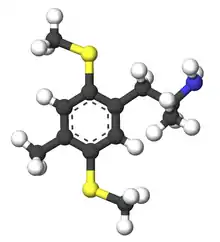 | |
 | |
| Names | |
|---|---|
| Preferred IUPAC name
1-[4-Methyl-2,5-bis(methylsulfanyl)phenyl]propan-2-amine | |
| Other names
4-Methyl-2,5-dimethylthio-amphetamine 4,alpha-Dimethyl-2,5-dimethylthiophenyl)ethan-alpha-methylamine | |
| Identifiers | |
3D model (JSmol) |
|
| ChEMBL | |
| ChemSpider | |
PubChem CID |
|
| UNII | |
CompTox Dashboard (EPA) |
|
| |
| |
| Properties | |
| C12H19NS2 | |
| Molar mass | 241.41 g·mol−1 |
Except where otherwise noted, data are given for materials in their standard state (at 25 °C [77 °F], 100 kPa).
Infobox references | |
Bis-TOM (4-methyl-2,5-dimethylthio-alpha-methylphenethylamine) is a substituted amphetamine. It is an analog of DOM. Bis-TOM was first synthesized by Alexander Shulgin. In his book PiHKAL, the minimum dosage is listed as 160 mg, and the duration unknown. Bis-TOM produces no psychoactive effects.[1] Very little data exists about the pharmacological properties, metabolism, and toxicity of Bis-TOM.
See also
References
- ↑ Shulgin, Alexander; Shulgin, Ann (September 1991). PiHKAL: A Chemical Love Story. Berkeley, California: Transform Press. ISBN 0-9630096-0-5. OCLC 25627628.
This article is issued from Wikipedia. The text is licensed under Creative Commons - Attribution - Sharealike. Additional terms may apply for the media files.